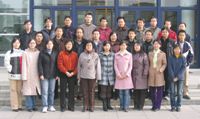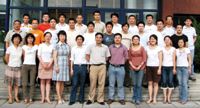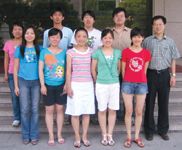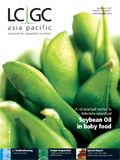Living in interesting times
This feature highlights some of the current analytical research being undertaken across China by focusing on the work of several research groups at academic institutions.
Chromatography at the National Chromatographic R&A Center, Dalian Institute of Chemical Physics
The major research interest of this high-efficiency separation and high-sensitivity characterization group is focused on the development of novel separation and detection techniques for proteome analysis. To achieve this goal, research on the following aspects has been performed:
1. Synthesis of monolithic materials. Monolithic materials have been regarded as a new generation of chromatographic stationary phases, offering the advantages of fast mass transfer, low backpressure and ease of modification. The group aims to synthesize various novel monolithic materials for the on-line selective concentration of phosphorated peptides by IMAC,1 the deleption of high-abundance proteins and enrichment of low-abundance proteins by MIPs, the development of immobilized enzymatic reactor2 and the synthesis of novel separation matrices for HPLC, CEC and immobilized pH gradient (IPG) for CIEF.3

2. Multidimensional separation platforms. To meet the greater and greater demands of proteome analysis, their emphasis is on the construction of different multidimensional separation platforms, including 2D-HPLC, 2D-CE4,5 and microchip 2D-CE. Consequently, optimization of separation conditions, design of 2D separation interfaces and preparation of novel stationary phases for microchip-based separations, form the basis of their studies.
3. On-line hyphenation with MS/MS. To achieve high sensitivity and high accuracy identification of proteins, their research is aimed at the development of various hyphenation techniques of HPLC, IPG-CIEF, CEC and pCEC6 with MS, with emphasis on the improvement of the compatibility of separation and identification systems.
For more information, contact Professor Lihua Zhang on e-mail: lihuazhang@dicp.ac.cn or visit www.proteomics.dicp.ac.cn/en_index.htm
References
1. Lingyi Zhang et al., Electrophoresis, 26, 2172–2178 (2005).
2. Jicheng Duan et al., Proteomics, 6, 412–419 (2006).
3. Guijie Zhu et al., Electrophoresis, 27, 3578–3583 (2006).
4. Hechun Liu et al., Anal. Chem., 76, 6506–6512 (2004).
5. Chun Yang et al., Anal. Chem., 75, 215–218 (2003).
6. Zhen Liang et al., Anal. Chem., 76, 6935–6940 (2004).
Bioanalysis at the National Chromatographic R&A Center, Dalian Institute of Chemical Physics
The major research interest of this group is method and technology development for analysis of biological samples.

Our studies on column technology focus on the development of monolithic capillary columns for automation of sample injection in nanoflow HPLC–MS–MS and multidimensional separations in proteome and peptidome analysis. An ultra-long capillary column (60 cm) with C18 monolithic silica stationary phase was developed for high-efficiency analysis of yeast proteome.1 SCX trap column systems with particulate packings2 and polymeric phosphate monolith3 have been developed for automation of sample introduction and two-dimensional separation of tryptic digests of proteins by nanoflow RPLC–MS–MS. In addition, preparation of polymeric monolithic columns in CEC and HPLC formats, as well as preparation of chiral stationary phases with cellulose derivatives-bonded silica gels and molecularly imprinted polymers have been extensively studied.
Development of methods and technology for sample preparation is another area of interest. MCM-41 nanoparticles with a pore size of 20.5 Å have proved effective for enriching peptides in human plasma with a wide MW range (1–12 kDa), while repelling most other plasma proteins.4 New IMAC adsorbent produced by Zr4+ chelation with phosphophate modified GMA-EDMA polymer beads was prepared, which demonstrated high specificity and selectivity in enrichment of phosphopeptides for phosphoproteome analysis.5 Also the methods for efficient extraction of proteins in bone tissues6 and formalin-fixed tissues7 were developed for shotgun proteome analysis.
The interactions between small molecules and biomacromolecules represent one of the most important parts of interconnected biological networks, which lead us to study their interactions from simple to complex systems.8 Biological fingerprinting analysis (BFA) has been proposed to characterize the interactions of multiple small molecules in extracts of traditional Chinese medicines with a biomacromolecule target based on affinity chromatography or microdialysis sampling–HPLC.9 A chemproteomics approach was also applied to probe the interactions of a small molecule with the multiple proteins in living samples such as human serum and cell lysates.10
Matrix-assisted laser desorption/ionization time-of-flight mass spectrometry (MALDI-TOF MS) is a powerful tool for protein and peptide analysis. A novel MALDI matrix [3,4-diaminobenzophone (DABP)], has been found with high tolerance for salts and detergents in MALDI MS analysis, which can effectively suppress the cation ion adduction of peptides in the presence of high concentrations of metal ions in sample solution.11 It was further observed that DNA segments with sequences smaller than 30-mers could be analysed by DABP with significantly lower laser powers, lower detection limits, less fragmentation and less intense alkali ion adduct peaks when compared with other conventional matrices used alone.12 The carbon nanotube obtained from coal by arc discharge was adopted as a novel matrix for the analysis of low molecular weight compounds by MALDI-TOF MS in our laboratory,13 which can eliminate the matrix ion interference of conventional organic matrices. The efficiency of desorption/ionization for analytes and the reproducibility of peak intensities within and between sample spots can be greatly enhanced by using an oxidized carbon matrix.14
For more information, contact Professor Hanfa Zou on e-mail: hanfazou@dicp.ac.cn or visit www.bioanalysis.dicp.ac.cn
References
1. Mol. & Cell. Proteomics, 5, 454–461 (2006).
2. Proteomics, 7, 528–539 (2007).
3. Anal. Chem., in press.
4. Angew. Chem. Int. Ed., 46, 962–965, (2007).
5. Mol. & Cel. Proteomics, in press.
6. J. Proteome Res., 6, 2287–2294, research profile paper (2007).
7. J. Proteome Res., 6, 1038–1047 (2007).
8. Mini-Rev. Med. Chem.,7(1), 87–98 (2007).
9. J. Comb. Chem., 8(4), 544–550 (2006).
10. J. Chromatogr. A, 1134, 134–142 (2006).
11. Anal. Chem., 78, 2593–2599 (2006).
12. Nucleic Acids Res., 34(13), No. e94 (2006).
13. Anal. Chem., 75, 6191 (2003).
14 J. Am. Mass Spectrom., 15, 263–270 (2005).
Separation Materials for Chromatography at Wuhan University
The major research interest of this group is to develop new separation media and apply them to various analytical challenges.

One focus is the preparation of HPLC stationary phases based on novel methods and technologies in material science. Various macrocyclic compound-immobilized silica particles have been synthesized which exhibit good separation of fullerenes. In a recent project the group proposed a new approach to prepare humic acid-bonded silica particles and used them as a novel solid-phase extraction sorbent to extract benzo[a]pyrene from edible oils. As the silica can only be used within the pH range of 2–8, the group aim to prepare zirconia and its composites as stationary phases, via the Lewis acid-base interaction, which are stable in extreme pH conditions.
Another focus is the development of different monolithic materials including organic polymer, hybrid organic-inorganic and inorganic monoliths. The interconnected through pores in the monolith facilitate convective mass transfer and allow fast separation of the analytes with high column efficiency. They have two primary interests in this area: improvement of the preparation methods of monoliths and application of organic or hybrid organic-inorganic monoliths to in-tube SPME, which is coupled on-line to different separation and detection systems, such as HPLC, capillary HPLC, CEC and MS, to analyse and determine various compounds (drugs, food additives, pesticides, etc.) in complex matrices. The latter has important implications for drug and food control. Recently they proposed a new mode of microextraction called polymer monolith microextraction (PMME) by fixing a polymer monolithic capillary in the pinhead of a syringe, which could be easily coupled off-line to various analytical techniques.
Finally, they have introduced macrocyclic molecular cucurbituril into CE and HPLC separations and established a method to estimate the inclusion complex formation constant of cucurbituril with other compounds, which provides a useful means for host-guest studies.
For more information, contact Yu-Qi Feng on e-mail: yqfeng@public.wh.hb.cn or visit www.chem.whu.edu.cn
Selected Publications
1. Dan Luo et al., Analytica Chimica Acta, 588(2), 261–267 (2007).
2. Min Zhang et al., J. Chromatogr. A, 1102(1–2), 294–301 (2006).
3. Jing-Fang Huang, Hui-Juan Zhang and Yu-Qi Feng, Journal of Agricultural and Food Chemistry, 54(25), 9279–9286 (2006).
4. Wei F et al., Electrophoresis, 26(11), 2214–2224 (2005).
5. Qiong-Wei Yuet al., Anal. Chim. Acta, 559(1), 79–88 (2006).
Ion Chromatography at Zhejiang University
This group is a joint team of 20 staff and students from the Department of Chemistry at Zhejiang University and Biology & Environment College at Zhejiang Shuren University. Their research is focused on ion chromatography (IC) and related techniques including new separation media and materials, hyphenated systems, miniaturized separation technologies, detection and identification technologies, element speciation, theory and simulation of separation processes, and a wide range of applications. Currently, they are working on the following areas:

1. Development of novel stationary phases, particularly polymeric monolithic phases and monodisperse porous particle phases for applications in capillaries and conventional HPLC columns. Some are ion exchangers designed for ion chromatography and some are receptor-ligands for affinity chromatography.
2. Study of the zwitterionic eluent for ion exchange chromatography, ion pair chromatography and ion exclusion chromatography.
3. Applying hyphenated techniques for coupling IC with mass spectrometry for analysing structure and molecular weight of polar and ionic species. The coupling of IC with element-specific detection techniques including atomic absorption spectrometry (AAS), inductively coupled plasma atomic emission spectrometry (ICP-AES) and inductively coupled plasma mass spectrometry (ICP-MS), is being studied for speciation of elements.
4. Developing applications of ion chromatography in a wide range of areas, including environment monitoring, power plants, chemical engineering, semiconductors, electroplating, food and beverage analysis, and pharmaceutical analysis.
5. Theory and simulation. We focus on a mixed-mode mechanism of ion exchange and hydrophobic interaction occurring in ion exchange chromatography and quantitative structure retention relationship (QSRR).
For more information, contact Professor Yan Zhu on e-mail: zhuyan@zju.edu.cn or visit www.chem.zju.edu.cn/
Separation Science at the Shanghai Institute of Organic Chemistry, Chinese Academy of Sciences
One interest of the Kang research group is to develop novel high-throughput and cost-effective methodologies for drug screening. Most recently, we have developed a capillary electrophoresis (CE)-based immobilized enzymatic reactor (IER) for enzyme inhibitor screening in natural extracts. The method combines the separation function of CE with an on-line assay of enzyme activity by creating an enzymatic reactor on the head of the capillary using an ionic-bonding process. The protocol is very simple, automatic and robust, and because the enzyme can be reused the assay cost can be dramatically reduced. Two drug target enzymes — angiotensin converting enzyme (ACE) and acetylcholinesterase (AChE) — were employed as models for successfully demonstrating our new strategy. It was proved that the prepared IERs displayed sufficient activity and stability as a result of ionic-bonding immobilization, which is rather mild compared with covalent-bonding immobilization. Furthermore, the IER can be easily renewed because the ionic-bonding immobilization is reversible. In our experience, the z' factor (used for evaluating the accuracy of a high-throughput screening method) was higher than 0.9 implying an excellent screening method. In most instances, concentration of the active component in the natural extracts is very low. Consequently, the required amount of target enzyme should be as low as possible to achieve satisfactory assay sensitivity. Our method just fulfills this requirement. On the one hand, the open tubular format of the enzymatic reactor prevents column contamination from the sample matrix; while on the other hand, the separation function of CE prevents interferences from the sample matrix.

Another research interest deals with metabolic flux analysis (MFA) of Clostridium acetobutylicum, a solvent-producing bacterium that is the potential source of biofuel. In recent years, MFA has become one of the major tools in metabolic engineering. We aim to precisely measure all metabolic fluxes in the metabolic network of the bacterium using separation tools such as CE, GC–MS and HPLC–MS–MS. Subsequenly, the results will form a flux map from which it may be possible to identify targets in the central metabolic pathways that can be manipulated to improve the solvent production through metabolic engineering.
For more information, contact Professor Jingwu Kang on e-mail jingwu.kang@mail.sioc.ac.cn or visit www.sioc.ac.cn
Separation Science at Sun Yat-Sen University
The major research of this group is focused on the development of modern sample preparation techniques and their applications to trace analysis of complex systems, including environmental, food and biological samples. They also study both analytical- and preparative-scale separation methods for Chinese traditional medicine.

First, they aim to develop novel extraction media to obtain highly selective and effective enriched capacity for trace analytes in complex samples. We have prepared poly(dimethylsiloxane), β-cyclodextrin and anilinemethyltriethoxysilane as solid-phase microextraction (SPME) stationary phases. Recently, we have investigated the use of molecularly imprinted polymers (MIPs) as sorbents in SPME, stir bar sorptive extraction (SBSE), membrane separation and magnetic microsphere separation. The MIP-SPME fibres have been successfully applied to the separation and concentration of analytes in environmental, food, agricultural product and drug analysis using prometryne, tetracycline and propranolol as templates. They have also developed a series of SPME and liquid-phase microextraction (LPME) devices for sample preparation.
Second, they are studying the microwave-assisted extraction (MAE) technique and its application to trace analysis of complex systems and extraction of active ingredients in Chinese traditional medicine. They have developed a vacuum microwave-assisted extraction (VMAE) technique to reduce the instability of thermosensitive compounds. In addition to the analytical work, they are also studying preparative-scale separations to achieve pure samples, in particular using MAE coupled with high-speed countercurrent chromatography (HSCCC).
Third, they have an interest in studying biological samples, including genetically modified plants, and biologically volatile organic compounds in animals and plants using novel sampling techniques and appropriate data processing methods.
The group works at the School of Chemistry and Chemical Engineering at the Sun Yat-Sen University, Guangzhou, China. They are very fortunate to have access to modern laboratories, housing a wide range of instrumentation, including HPLC, LC–MS, GC, GC–MS and a series of modern sample preparation devices.
For more information, contact Professor on e-mail: Gongke Licesgkl@mail.sysu.edu.cn
Selected Publications
1. Yuling Hu et al., Analytica Chimica Acta, 543,17–24 (2005).
2. Zhuomin Zhang et al., Journal of Chromatography B, 822, 244–252 (2005).
3. Yuling Hu, Yueli Fu and Gong-Ke Li, Analytica Chimica Acta, 567, 211–217, (2006).
4. Yueli Fu et al., Journal of Separation Science, 29, 2684–2691 (2006).
5. Fuyou Du, Xiaoxua Xiao and Gongke Li, Journal of Chromatography A, 1140, 56–62 (2007).
6. Xiaogang Hu, Yuling Hu and Gongke Li, Journal of Chromatography A, 1147, 1–9 (2007).
7. Yuling Hu et al., Journal of Chromatography A, 1148, 16–22 (2007).
8. Guihua Ruan and Gongke Li, Journal of Chromatography B, 850, 241–248 (2007).
9. Zhuomin Zhang and Gongke Li, Microchemical Journal, 86, 29–36 (2007).
10. Zhuomin Zhang, Dandan Zeng and Gongke Li, Flavour and Fragrance Journal, 22, 71–77 (2007).
11. Gongke Li, Yuling Hu and Guihua Ruan, Instrument and Device for Sample Preparation, Chemical Industry Press, Beijing, China, May, (2007).

University of Rouen-Normandy Scientists Explore Eco-Friendly Sampling Approach for GC-HRMS
April 17th 2025Root exudates—substances secreted by living plant roots—are challenging to sample, as they are typically extracted using artificial devices and can vary widely in both quantity and composition across plant species.
Thermodynamic Insights into Organic Solvent Extraction for Chemical Analysis of Medical Devices
April 16th 2025A new study, published by a researcher from Chemical Characterization Solutions in Minnesota, explored a new approach for sample preparation for the chemical characterization of medical devices.












